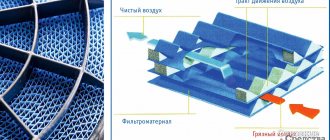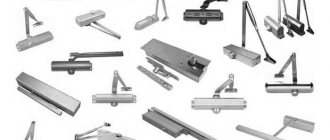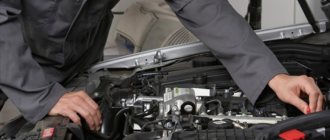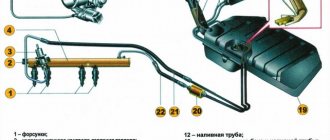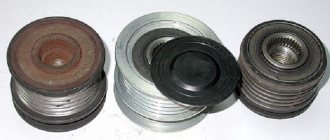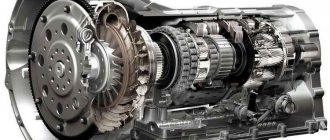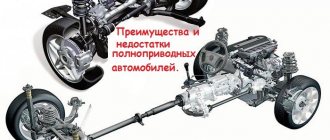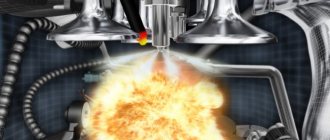A six-cylinder diesel engine with four turbochargers was not the prerogative of BMW’s flagship “seven” for long: it appeared with this engine less than a year ago, and now the M550d model can boast of the same heart.
Let us remind you that the three-liter B57D30C engine of the modular family became the world’s first serial diesel engine with four superchargers. It has two low-inertia high-pressure turbochargers and two low-pressure “turbines” that operate sequentially. Moreover, one of the high-pressure compressors is connected only during intense acceleration - and only after the crankshaft spins to 2500 rpm. And piezo injectors inject fuel into the cylinder at a pressure of 2500 bar!
Compared to the performance of the previous three-turbine diesel engine of the N57 series, the maximum output has changed slightly: power has increased from 381 to 400 hp, and torque from 740 to 760 Nm. However, traction is still limited by the capabilities of the current ZF eight-speed automatic transmission: with the advent of the new gearbox, the limitation will be lifted and the peak torque will exceed 800 Nm. But the main advantage of the four-charging design is different: 450 Nm of thrust is available already at 1000 rpm! The engine should rev vigorously from idle, although peak torque is achieved in the same range as its predecessor: from 2000 to 3000 rpm.
The all-wheel drive BMW M550d xDrive sedan with a new diesel engine accelerates from zero to 100 km/h in just 4.4 seconds - 0.3 seconds faster than the previous model with a three-supercharged engine and only 0.1 seconds slower than the rear-wheel drive BMW M5 with a 560-horsepower twin-turbo eight. ! The station wagon is less efficient: 4.6 seconds to “hundreds”. The maximum speed is traditionally limited to 250 km/h, and the diesel fuel consumption is reduced by 11% (for the sedan, on average, up to 5.9 l/100 km).
Since the four-supercharged “five” belongs to the M Performance family, it has the corresponding insignia: an M body kit, a sports suspension lowered by 10 mm, a steering mechanism on the rear axle, 19-inch wheels, stronger brakes and a different exhaust system. In Europe, BMW M550d sedans will go on sale in July, and station wagons will follow by the end of the year. Nothing prevents us from bringing these cars to Russia, because the “Seven” with such a diesel engine is sold here.
For many decades, the German concern BMW produced only passenger cars, but since 1999 the company began producing crossovers, and the first model produced was the X5 in the E53 body. The first BMW X5 diesel appeared in 2001 - it was a car with a three-liter 184-horsepower M57 engine.
As of March 2020, the 5th series of Bavarian SUVs includes three generations in bodies:
- E 70;
Diesel X5 cars are practical and perform well, but they have both advantages and disadvantages, and they will be discussed in this article.
BMW X5 E53 diesel
It is traditionally believed that diesel engines are noisy and are not designed for high speed, but they are high-torque and economical. The BMW concern decided to prove that this is not entirely true - and indeed, BEC diesel engines operate with low noise and almost no vibration, and have good speed characteristics.
The BMW X5 E53 crossover was first equipped with a diesel engine in 2001, but the M57 internal combustion engine itself has been produced since 1998; it is one of the best power units in the BMW diesel engine line. The M57D30 engine is an in-line six-cylinder turbodiesel with a cast-iron cylinder block and an aluminum cylinder head, with 4 valves per cylinder. This engine was the first to use the Common Rail injection system; in it, the fuel injection pressure does not depend on the number of revolutions of the internal combustion engine. M57D30 was also installed on BMW cars:
- 530 E39;
- 330 E46;
- 730 E38.
In 2003, the M57D30 diesel engine on the X5 crossover was replaced by a newer M57TUD30 power unit, with the same cylinder volume (3.0 l), the engine power increased by 34 hp. With.
Diesel overhaul
BMW diesel overhaul is a complete package of services. However, often the driver comes to solve a specific problem, which means the diesel operator will work within the framework of the assigned task.
Types of work that we perform on diesel modifications of BMW:
- Replacing piston rings
- Adjustment of valves
- Changing gaskets (manifold, cylinder head, crankcase, valve cover, etc.)
- Removal (dismantling) and installation of the engine
- Installing a particulate filter
- Fuel system repair (fuel injection pump)
- Installation of new diesel injectors
- Replacing glow plugs
- Replacing drive belts
- Installing a new chain guide and tensioner
- Replacing the timing chain and adjusting it
- Changing valve stem seals
- Replacing the oil pump
- Diesel pump replacement
- Repair of the cylinder head (cylinder head)
- Replacing the rear crankshaft oil seal
- Replacing the camshaft and its oil seal
- Replacing the front and rear crankshaft oil seals
Overhauling and troubleshooting the engine will take a certain period of time, which directly depends on the stock of necessary spare parts in our warehouses. In some cases, the required part may not be included in the list of basic purchases of consumables. This requires additional time to reorder the required item. We are ready to find any BMW diesel engine parts.
We offer to overhaul the engine within a clearly defined period, which is indicated when drawing up the certificate of acceptance of the car for repair. The selection of new parts is carried out based on identified problems. We purchase all elements through our proven supply channels, which distribute both non-original spare parts and original parts for sale.
BMW X5 E70 diesel
The BMW X5 E70 is the second generation of popular German SUVs; this model was produced from 2007 to 2013. On the pre-restyling BMW X5 E70 crossover, diesel engines came with a volume of 3.0 liters in two versions:
- M57TU2D30-OL (3.0d) – 235 hp. With.;
- M57TU2D30-TOP with turbocharger - 286 hp. With.
Since 2010, the line of diesel engines on the X-Fifth has been updated - instead of the M57 series engines, N57 diesel engines have been installed. Motors of this family, depending on the modification, have a different number of turbines; fuel is injected into the cylinders at different pressures. In the restyled version of the BMW X5, the power of the 30d internal combustion engine was increased from 235 to 245 hp. s., and in the diesel version with twin turbocharging (40d) – up to 306 hp. With.
BMW X5 cars with 3.0 diesel engines are rarely found on Russian roads - such crossovers were not officially sold in Russia, these cars were mainly imported from Europe. Potential buyers are often faced with the choice of buying a BMW X5 with a diesel or gasoline engine. The advantages of BMW diesel engines are obvious:
- low fuel consumption;
- good dynamics;
- high reliability.
But BMW X5 cars with diesel engines encounter many different problems. One of the diseases of all modern diesel engines is a clogged particulate filter. This element of the exhaust system runs smoothly for approximately 100 thousand km, then it begins to clog. Replacing a particulate filter is very expensive; alternatively, it can be cut out, but in this case the control unit will need to be reflashed.
All diesel internal combustion engines are also very critical to the quality of engine oil and diesel fuel, but if the car is operated carefully (pass maintenance on time, do not overload or overheat the engine), the power unit can last a long time, and it will not cause trouble to the car owner. Motors of the M57 series have the following characteristic faults:
- injectors become clogged, this problem is especially common on internal combustion engines after 2003;
- the gas recirculation valve “dies”;
- cracks form in the exhaust manifold;
- at a mileage of 200-250 thousand km the turbine fails;
- the swirl flaps break, the consequences can be sad - the pistons are broken by fragments, the surface of the cylinders is lifted.
Engines of the N57 series operate quite quietly; if you do not open the hood, you might think that a turbocharged gasoline engine is installed. Three-liter N57 diesel engines have little vibration and operate smoothly. Without problems, these engines last for at least 200 thousand km; the further fate of the internal combustion engine depends on operating conditions - in principle, they can last 500 thousand km or more. BMW diesel engines have one important advantage over gasoline engines - they consume less oil. If a gasoline engine already starts to “eat up” oil at a mileage of closer to 50 thousand km, then a diesel internal combustion engine may consume almost no oil during its entire service life.
What engines were installed on the BMW X5 E70. What are the problems with them? — BMW X5 car
January 6, 2014
Usefulness: (6 votes, average: 4.83 out of 5)
In this short article we will look at the main power units of the BMW X5 E70, as well as the problems that owners talk about.
xDrive30d (235 hp) (3.0, diesel)
On this unit, sometimes there is a failure of the turbine vacuum valve, and sometimes extraneous noise appears during intense acceleration (at about 3 thousand revolutions). This sound is not due to any malfunction. Yes, he is unpleasant, but it is useless to fight him. You can read more about this engine here.
Inline six N52 3.0si (272 hp)
In this engine, knocking of the hydraulic compensators was often observed when cold or after several short runs without complete warming up. In this case, it was recommended to replace the cylinder head assembly, but there is a cheaper way - to replace the hydraulic compensators. As the owners say, this solution only allowed them to forget about the problem for a while, but did not eliminate it.
It is also necessary to periodically change the crankcase ventilation valves (CVVV). It is built into the valve cover. The gas exhaust channels become clogged, and in winter it can lead to freezing and oil squeezing out.
A similar problem was observed in the fifth one in the 53rd body. Engineers modified the system, but did not completely eliminate the defect. It was only possible to increase the operating life of the KVKG to 60 thousand km. The price of a new cover is about 3-5 thousand rubles.
There is also a known problem with VANOS gas distribution with mileages of more than 120 thousand km. When the valves are wedged, the engine begins to stall, fuel and oil consumption increases. The cost of repairs is approximately 10-16 thousand rubles.
4.8i (355 hp) petrol eight
This engine is the most reliable among all E70 power plants. The only thing is that with runs over 100 thousand km. Oil consumption may increase slightly. The reason is stiffened valve stem seals. At such runs, the crankshaft oil seals may leak. Repairing both the first and second faults will not bankrupt the owner. These shortcomings can be attributed to the peculiarities of operation.
Common weaknesses of all BMW X5 engines
- You can often see a broken drive belt roller bolt (relevant for cars produced in 2008-2009). BMW recalled such cars for modification, but not all of them managed to eliminate the fault during the recall campaign.
- Radiator leakage at 60-100 thousand km. The cost of repairs is approximately 8 thousand rubles
- Failure of the electric pump with mileage of about 100 thousand. The cost of repair is about 10 thousand rubles.
- The engine sump is cracking. Most often, the reason is that the tightening torque of the drain bolt is exceeded. To replace the pan, you need to hang the engine. A new pallet from the officials costs about 25 thousand rubles, and a replacement costs about 18 thousand.
- With an aggressive driving style, up to 80-100 thousand km. mileage, the transfer case servomotor fails. The assembled transfer case will cost 120 thousand rubles, the servomotor separately will cost about 30 thousand.
- The rear gearbox breaks down after driving more than 120 thousand km. on pre-restyling E70. The cost of a new gearbox is about 90-100 thousand rubles.
- Shocks occur after stopping or when changing gears. To solve this, you first need to change the oil, if that doesn’t help, reflash the transmission ECU. In 99% of cases these measures are sufficient.
Despite all the above disadvantages, the BMW X5 is quite reliable. All its disadvantages appear only with intensive sawing by the owners. With careful driving, most problems do not appear.
www.myx5.ru
BMW X5 diesel fuel consumption
Diesel engines are always more economical than gasoline engines, and like all other car models, fuel consumption on the BMW X5 with diesel engines largely depends on operating conditions, driving style, and time of year. In winter, additional fuel is spent on warming up the engine; in urban conditions, diesel fuel is always consumed more. The transmission also matters - a car with an automatic transmission increases fuel consumption compared to a car with a manual transmission.
On a BMW X5 E53 crossover with a 3-liter diesel engine, highway consumption averages 8-10 l/100 km (depending on the control unit firmware), in the city – from 12 to 16 l/100 km. For 40d engines, the technical specifications indicate consumption per hundred kilometers of 5.8 liters on the highway and 7.1 liters in the city.
BMW X5 cars with diesel engines have good acceleration - they accelerate to “hundreds” no worse than cars with gasoline engines of the same volume. X-Fifth car owners like the excellent dynamics of the crossover, good handling, and economical fuel consumption. Diesels of the N57 series turned out to be more advanced in terms of performance characteristics:
- easier to start in cold weather, at almost any sub-zero temperature;
- accelerates as quickly as gasoline engines;
- At idle speed they operate smoothly, with virtually no vibrations.
If a car with an N57 diesel engine is operated carefully, the turbine can last a long time. Another positive point is that almost all diesel X5s are equipped with a Webasto starting heater. The heater increases comfort - passengers always get into a warmed-up car, and warming up also saves engine life.
Car owners also note the disadvantages of diesel engines:
- such power units are good until they break, and if repairs are required, they are expensive;
- engines are demanding on the quality of fuel and engine oil.
The M57 internal combustion engines are famous for their long service life; in some cases, diesel engines could travel even a million kilometers without major repairs. Car owners note few disadvantages of these power units; the main faults are:
- premature failure of the crankshaft pulley;
- loosening of the intake manifold flaps;
- clogging of fuel injectors in the Common Rail system.
This is not to say that problems occur quite often, but the problems listed above are the most typical for the M57 internal combustion engine. In general, there are good reviews about BMW X5 diesel cars, and shortcomings can be found in any car model if desired.
People often ask the same question about “what does BMW have with diesel engines?”, or “which diesel should I buy”? Instead of an answer, accept a short essay on the topic “diesel in BMW”.
A diesel internal combustion engine has a higher efficiency in full load mode and noticeably higher efficiency in partial load and idle mode. A gasoline engine is hampered by the principles of its operation - the presence of a throttle, the formation of a mixture outside the combustion chamber, the inability to operate on lean mixtures. Partial load mode is inconvenient and extremely harmful for him. In this sense, the benefit of a diesel engine is absolute
- its average temperature is noticeably lower, and at partial loads and idling, a modern diesel engine may not even warm up to the nominal operating temperature. Thanks to these features, the diesel engine is almost not afraid of traffic jams, and even more so of idling: it’s not so scary to bother it with everyday start-stop traffic jams. The heat emission of a diesel engine (turbodiesel) is not only lower, but also “smarter” - the presence of a turbine is almost a guarantee that in a traffic jam you do not load the engine with excessive power - at low speeds it almost does not work.
The bottom line is, from the point of view of the load on the oil, which, by the way, is always about 20% more in a diesel engine than in a gasoline counterpart of the same displacement, diesel is qualitatively superior to a gasoline engine.
You can also recalculate, for example, the average power released per volume of oil, etc. — in all this, the diesel internal combustion engine wins by a margin and “with a clear advantage.” And if we also remember the “traditionalist” conservative habits and fads of changing the oil in a diesel engine every 7-10 thousand kilometers (well, of course, we have “dirty diesel fuel” - and advertising blatantly lies to us about EURO5, and the oil is already “ black" is such), then diesel, from the point of view of the expected resource, is almost eternal even under Russian operating conditions. Let’s add here a few more possible factors characterizing the likely favorable driving conditions of such cars - diesel engines are often bought by those who drive far and at high average speeds...
Total: a modern diesel engine differs significantly from a modern gasoline engine in terms of expected service life precisely due to a successful combination of technological features. I’ll tell you exactly how much below.
Now the questions that are often asked on this topic:
How modern are BMW diesel engines?
BMW makes some of the highest quality and most modern diesel engines - they are economical, high-torque and reliable. In the most modern versions, they are also very quiet, which cannot be said about most competitors. For the last 20 years, BMW has been doing nothing but turning its successful gasoline engines “into diesel engines,” trying to extract “ecology and economy” from them through monstrous technological tricks. The results, if you do not take into account victories in competitions such as “engine of the year,” are actually disastrous. But the design of the diesel engine is devoid of a huge amount of technological and environmental waste: VANOS, Valvetronic, controlled thermostat, and so on. Diesels are just improving in technology, with minimal environmental problems. As of 2012, diesel unconditionally wins the gasoline/diesel battle.
What can you say about specific models?
M21 - never seen it. M51 - seen a couple of times, an ordinary horse-drawn tractor. The M57 is a great option for the X5. It seems strange to me on a sedan, although this is a matter of taste. The N57 is a quiet diesel engine with an almost “gasoline” feel. If not for the short rev range, it would be difficult to distinguish it from a gasoline turbo engine. N47/M47 are loud, but very economical engines. There are seemingly already solved problems with the timing belt, which are not at all easy to solve if you do encounter them. In any case, this is a choice to save money.
Are there any statistics?
Full measurement and inspection of diesel internal combustion engines requires dismantling the injectors. This is not a quick or cheap procedure. I don’t have measurement statistics for these motors, and in general there are few requests for them. The reasons are explained in the next paragraph.
Resource?
Even with an unsuccessful “recommended” oil and equally unsuccessful analogues of this oil, you risk driving
200-250 thousand km or even more
. And this is practically without oil consumption and on almost any of the BMW diesel engines. With the condition, of course, that the engine was not overheated and was operated normally. Subsequently, problems will arise approximately the same as with their gasoline counterparts. The processes in the CPG there are completely similar, they just happen more slowly and the threshold of visibility is thus pushed back to a guaranteed 5-7 years of completely trouble-free operation. The higher your annual mileage and the higher your average speed, the further away the onset of problems with oil consumption is. What the owner of a gasoline engine should worry about already at a mileage of 40-60 thousand (!), its diesel counterpart may not be bothered at all for the entire time he owns the car.
Problems?
I think the main problem is the fuel equipment - it’s really expensive for a diesel engine. One gas station filled with sand and repairs can surprise you with its cost. However, if you use “standard” oil, problems will definitely appear at the above interval, it’s just that most will not even consider them problems. The vast majority of petrol BMW owners show no signs of concern at all until the oil consumption reaches 1 liter per 1000 km. In the case of a diesel engine, which most likely will not consume oil at all during the first years of operation, the owner will not be afraid of 1, 2 or even 3 liters per 10,000 km. Most likely, the logic “well, thank you for holding out for 5 years, and now you can forgive me” will work, instead of the reasonable logic “I haven’t eaten at all, why did I start now?”
List of all BMW engines. Options for 1-, 2-, 3-, 4-, 6-, 8-, 10-, 12- and 16-cylinder power units, their technical characteristics, photos, years of manufacture, models on which they were used.
Signs of BMW engine wear
Even an inexperienced driver can notice signs that a BMW engine needs major repairs. Signs that clearly indicate the need for major repairs are:
- high oil and gasoline consumption;
- smoky exhaust;
- engine malfunctions at idle;
- extraneous noises, grinding, knocking in the engine;
- a sharp drop in power.
The more signs you notice from the above, the sooner you need to contact a car service.
BMW petrol engines
- M240/M241 (1954-1962) 0.2-0.3 l.
- M102 (1957-1959) 0.6 l.
- M107/M107S (1959-1965) 0.7 l.
- W20 (since 2014) 0.6 l.
New generation of engines installed on MINI and BMW cars:
- B38 (since 2011) 1.2-1.5 l. (DOHC)
BMW inline 4 cylinder petrol engines
An inline four-cylinder engine or straight four-cylinder engine is an internal combustion engine that is mounted directly or parallel to the crankcase.
The cylinder block can be oriented in a vertical or inclined plane with all the pistons on the crankshaft.
The inline four-cylinder engine is designated I4 or L4. Below is the range of BMW engines:
- DA - motor for Dixi (1929-1932) 0.7 l.
- M68 (1932-1936) 0.7-0.8 l.
- M10 (1960-1987) 1.5-2.0 l. (SOHC)
- S14 (1986-1991) 2.0-2.5 l. (DOHC)
- M40 (1987-1995) 1.6-1.8 l. (SOHC)
- M42 (1989-1996) 1.8 l. (DOHC)
- M43 (1991-2002) 1.6/1.8/1.9 l. (SOHC)
- M44 (1996-2001) 1.9 l. (DOHC)
- N40 (from 2001 to 2004) 1.6 l.
- N42 (2001-2004) 1.8-2.0 l. (DOHC, VANOS, Valvetronic) - won the international award ""
- N43 (2007-2011) 1.6-2.0 l. (DOHC, direct injection)
- N45 (2004-2011) 1.6-2.0 l. (DOHC, VANOS)
- N46 (2004-2007) 1.8-2.0 l. (DOHC, VANOS, Valvetronic)
- N13 (2011) 1.6 l. (turbocharged, DOHC, VANOS, VALVETRONIC, direct injection)
- N20 (2011) 2.0 l. (turbocharged, DOHC, VANOS, VALVETRONIC, direct injection) - won the international award “Engine of the Year in Europe”
- N26 (2012) 2.0 l. (turbocharged, DOHC, VANOS, VALVETRONIC, direct injection)
- B48 (2013)
- P45 (2.0 l.)
BMW inline 6 cylinder petrol engines
They are best known for their inline six-cylinder engines. The six-cylinder in-line engine is an internal combustion engine.
All six cylinders are arranged in a row, in the following order: 1-5-3-6-2-4. The pistons rotate via one common crankshaft. Designated as R6 - from the German "Reihe" - row, or I6 (Straight-6) and L6 (In-Line-Six).
The cylinders can be in a vertical position or at a fixed angle relative to the vertical.
When the cylinders are tilted vertically, the engine is usually called Slant-6.
V-twin engine - all six cylinders are arranged in two rows of three cylinders per row, thus forming a V-twin arrangement. The pistons rotate on one common crankshaft. Designated as V6 (from the English “Vee-Six”). The V-twin engine is the second most popular after the inline-four engine. The cylinder camber angles are 90, 60 or 120 degrees. There are also options of 15°, 45°, 54°, 65° or 75°.
Currently, BMW produces 6-cylinder engines with in-line cylinders.
Below are the modifications of BMW engines:
- M78 (1933) 1.2-1.9 l.
- M328 (1936) 2.0-2.1 l.
- M335 (1939) 3.5 L.
- M337 (1952) 2.0-2.1 l.
- M30 (1968) 2.5-3.5 l.
- M20 (1977) 2.0-2.7 l. (SOHC. Early versions of the M20 are sometimes called "M60", although the M60 has since been used for the V8 engine first delivered in 1992)
- M88/M90 (1978) 3.5 l. for M1/M5/M6
- S38 (1986 - 1996) up to 3.8 l. (DOHC)
- M102 (1980) 3.2 L. (turbo)
- M106 (1982) 3.4 L. (turbo)
- M50 (1989) 2.0-3.0 l. (DOHC 24V with VANOS on M50TU)
- M52 (1994) 2.0-2.8 l. (DOHC 24V with VANOS/Double-VANOS on M52TU) - two International Engine of the Year awards
- S50 (1995) 3.0 l. (for BMW M3)
- S52 (1996) 3.2 l. (for BMW M3)
- M54 (2000) 2.2-3.0 l. (aluminum DOHC 24V with Double-VANOS)
- M56 (2002) 2.5 l.
- S54 (2002) 3.2 l. (DOHC) - six Engine of the Year awards
- N51 (motor for US cars)
- N52 (2005) 2.5-3.0 l. (magnesium/aluminum DOHC 24V with Double-VANOS and Valvetronic) - two Engine of the Year awards
- N54 (2006) 3.0 l. (aluminum DOHC 24V turbocharged) - five International Engine of the Year awards
- N53 (2007) 2.5-3.0 l. (magnesium/aluminium/DOHC 24V with Double-VANOS and High Precision Injection (Gasoline Direct Injection))
- N55 (2009) 3.0 l. (TwinPower Turbo, Valvetronic and high-precision injection system)
- S55 (2013) 3.0 L (TwinPower Turbo, VALVETRONIC and Double-VANOS)
V-shaped 8-cylinder gasoline engines BMW
The 8-cylinder V-engine is an internal combustion engine.
All eight cylinders are arranged in two rows of four cylinders per row, thereby forming a V-shape arrangement.
The pistons rotate on one common crankshaft. Designated as V8 - (from the English “Vee-Eight”).
Below are BMW power units with 8 cylinders:
- BMW OHV V8 (1954 - 1965) 2.6-3.2 l.
- M60 (1992) 3.0-4.0 l.
- M62 - S62 (1994 - 2005) 3.5-4.4 l.
- N62 (2001) 3.6-4.6 l. (with SFI fuel injection, Double-VANOS and Valvetronic) - three International Engine of the Year awards
- N62/S (2004-2006) 4.8 l. for X5 4.8is
- P60B40 (2005) 4.0 L.
- S65 (2007) 4.0 L. for E90/92/93 M3 - two International Engine of the Year awards
- N63 (2008) 4.4 l. turbocharged
- S63 (2009) 4.4 l. turbocharged (TwinPower Turbo)
- P65 (4.0 l.)
V-shaped 10-cylinder petrol engine BMW
The V10 engine is an internal combustion engine with 10 cylinders arranged in two rows of five cylinders. Essentially the V10 is the result of crossing two inline 5-cylinder engines.
- S85 (2005) 5.0 L. for the E60 M5 and E63 M6 - four International Engine of the Year awards
V-shaped 12-cylinder BMW power units
The V12 engine is a V-twin engine with 12 cylinders mounted in two banks of six cylinders on a single crankshaft. Typically, but not always, 60° to each other. V12 engines have two rows of six cylinders arranged at angles of 60°, 120° or 180°.
- M70 (1986) 5.0 L.
- M72 (4-valve M70 prototype)
- S70 - S70/2 - S70/3 (since 1992) 5.6 - 6.1 l.
- M73 (1993) 5.4 L. — won the International Engine of the Year award
- N73 (2003) 6.0 l.
- N74 (2009) 6.0 l. with turbocharging (TwinPower Turbo, Valvetronic, Double VANOS and high-precision injection system)
BMW was the first German manufacturer to release a V12 engine in 1986, forcing Mercedes-Benz to follow suit in 1991. Only the 7 and 8 Series cars used V12 engines. While BMW sells far fewer V12-powered 7 Series cars than V8 versions, the V12 remains popular in the US, China and Russia, and maintains the prestige of the luxury car brand.
V-shaped 16 cylinder petrol engines BMW
The V16 engine is a V-twin engine with 16 cylinders. This engine is rare in automotive use.
- BMW V16 Goldfish (1987) 6.7 l. (Gold fish)
- Rolls-Royce 100EX (2004) 9.0 l. (V16 prototype engine)
BMW X5 E53 - choice - which engine - what to look for
The BMW X5 E53 is the first crossover of the BMW brand, which was launched in 1999. At the time of the start of production of the X5, the cost of the crossover was about $120,000, but despite the price tag, the crossover immediately became in demand among buyers.
The X5 crossover was produced until 2006, and in 2003 it “survived” restyling. Today, the price for an E53 body starts from ~ 400,000, it depends on the modification, configuration, condition and reaches ~ 1,500,000 rubles.
It is difficult to find a BMW X5 in good condition, so when choosing, you should not adhere to the deceptive rule - “expensive means high quality” - examine the car you like, drive it, and finally listen to your inner voice.
If you choose any model, you MUST carry out diagnostics, since the correct operation of the car depends on the condition of the system and the presence of errors in it, and some hidden problem areas may soon lead to expensive repairs.
In this article we will look at the features of the first crossover from BMW, its main problem areas and what you need to pay attention to when buying a BMW E53.
Restyling
What is the difference between restyling and pre-restyling?!
Visually, since this is the first thing we see in front of us. But do not forget that from pre-restyling it is quite possible to make a restyled model, and, if desired, at least an exact copy of the Le Mans prototype. It is possible to find out, for example, the equipment or production date by “punching” the VIN number of the car on special Internet services.
Various gearbox options in pre-restyling and restyling.
Drive differences. On a pre-restyling car, the all-wheel drive system distributes torque in proportion - 38% to the front wheels and 62% to the rear. On restyled models, the torque is distributed depending on the situation - from 0:100 to 50:50.
Body
The body of the BMW X5 E53 is not subject to corrosion, but there are also reckless drivers among its drivers. Therefore, check the body for any accidents.
When inspecting a dirty car, you should think about further “studying” it, since it is possible to hide many problem areas under the dirt.
Pay attention to the gaps between the body elements, they should be the same. Test all door hinges for sagging, especially on the driver's side, by opening the door and shaking it. Loose hinges may well be the result of a side impact.
The most problematic area of the BMW X5 body in the E53 body is the lower part of the rear lining under the lower tailgate, which is susceptible to corrosion due to moisture.
The paintwork on this crossover may not be perfect, and small chips and scratches are quite normal. Look at the backs of the doors for corrosion, and given the age of the car, pay more attention to its extent. A minor and barely noticeable manifestation of it can still be corrected, but a serious manifestation of corrosion in the future will lead to serious problems with the body.
Interior
While inside the car, the condition of some individual elements may well give an idea of the actual mileage of the car. Inspect the driver's seat, namely its sides, wear on the pedals and steering wheel, but you should also not forget about the linings on the above interior elements, the use of which may erroneously give an idea of the actual mileage. Also check the functionality of all buttons.
Without having any diagnostic equipment, it is impossible to find out the condition of car electronics. In such a situation, check the operation of the indicators on the instrument panel. Turn the ignition key and pay attention to the airbag indicator, which goes out a little later than the others, this will at least show you that the airbag indicator wire is not connected to any other wire.
Engines
Under the hood of the BMW X5, gasoline engines of 3.0, 4.4, 4.6 (pre-restyling only), 4.8 liters (restyling only) and a diesel power unit of 3.0 liters were installed.
Which engine to choose BMW X5 E53 with?! First of all, start from your budget and what you want to “get” from the car.
Popular and reliable
The most common and popular modification of the BMW X5 E53 is the 3.0i petrol version with the BMW M54 inline 6-cylinder power unit. This engine has proven itself well not only in the X5, but also in other BMW cars.
The BMW E53 3.0 cannot boast of particularly sporty dynamics (since, unlike, for example, the 530i in the E39 body, the X5 has slightly different aerodynamic characteristics, and the curb weight of the crossover is almost 0.5 tons more), but it will not deprive you of the pleasure of driving.
In the BMW X5 3.0 with M54, a common problem is leakage of the crankshaft rear oil seal, which will be clearly visible when the car is raised. If this problem occurs directly during the operation of the car, it is necessary to change the crankcase ventilation (once every 2 oil changes, that is, at ~ 30,000 km). The cause of this problem is clogging of the ventilation, as a result of which the oil begins to act under pressure, and since it is more difficult to push the gasket, it leaks through the rear crankshaft oil seal.
Carefully inspect the pan gasket. If oil oozes through the pan gasket, in most cases this indicates that there will be problems with the engine in the near future. The cause of the leakage is the squeezing of oil gases through the pan gasket.
Economical
The budget model BMW E53 3.0 diesel with a reliable M57 engine was offered in two versions - pre-restyling with a power of 184 hp. and after restyling 218 hp. It is worth noting that the restyled modification 3.0d in terms of dynamic performance is almost on par with the 3.0-liter gasoline version, and has significantly lower fuel consumption.
Powerful
When choosing with a V8 engine between the BMW E53 4.4 vs 4.6 vs 4.8 - again, proceed from your budget - for better dynamics and higher consumption you will have to pay extra not only for consumables, but also for car maintenance or repairs. For example, the timing belt chain on a 6-cylinder engine will last 2 times longer, while on a V8 the chain needs to be changed once every 200,000 km.
In this range, the most popular 8-cylinder model is the 4.4 (over 120,000 units produced in total). But it is worth noting that the fuel consumption of the restyled version 4.4 with the N62 engine is almost equal to the consumption of the 4.8-liter model with the same engine.
The motor itself (H62) is, on the whole, a reliable power unit, but given the length of operation, time takes its toll. The main problem areas of this engine are the valve stem seals, which lead to increased oil consumption and the appearance of “scuffing”.
As for choosing a BMW E53 4.6 equipped with a BMW M62 engine, you need to look at the car itself, or rather its condition. This model is available only in a pre-restyling body, and fuel consumption figures are slightly higher than those of the 4.8-liter model that replaced it in 2004.
What should you pay attention to?
When inspecting the engine, pay attention to the presence of fresh oil leaks on the sides.
As with any other engine, and not only the BMW brand, the cooling system may well overheat, and one of the popular overheating problems is a clogged radiator, which must be cleaned periodically. Pay attention to it when inspecting the engine compartment, and then draw your own conclusion based on its condition.
BMW engines are demanding on the quality of oil, so the manufacturer recommends using only high-quality synthetic oils, since it not only serves as a lubricant, but also cools the engine.
Transmission
BMW X5 E53 was equipped with a 5-speed manual and 5-, 6-speed automatic transmission.
Before the range was updated in 2003, all models were equipped with a 5-speed automatic transmission, and versions 3.0i/3.0d were also available with a 5-speed manual. After restyling, a 6-speed automatic transmission was installed on the crossovers.
In terms of reliability, there are no particular complaints about the BMW X5 transmission, and with proper care, as well as under moderate loads, there will be no problems in operation.
Despite the fact that the automatic transmission is considered “maintenance-free,” the oil still needs to be changed once every 60,000 km.
To check an automatic transmission before purchasing, set the gearshift lever to the “Drive” position, as a result of which the car should move independently, both forward and backward.
During the test drive, accelerate by pressing the gas pedal, when you hear a shift into second gear, release the gas pedal - if at this moment you feel a “kick” (a common automatic transmission problem), this means that the gearbox has technical problems.
Suspension
The suspension of the BMW X5 E53 is structurally similar to the suspension of the “five” E39, but less powerful, since the X5 has a slightly different purpose.
The service life of suspension parts directly depends on driving style and the quality of replacement parts.
Bottom line
In general, the first BMW X5 is a fairly reliable car, in principle, like any other vehicle, of course, taking into account the high-quality assembly, its components and driving style.
When buying a crossover, look first of all at the condition of the car, be sure to carry out diagnostics, and having two keys will be an advantage.
Good luck with your choice and enjoy driving.
www.bimmerfest.ru
BMW diesel engines
- B37 (since 2011) 1.5 l.
BMW inline 4 cylinder diesel engines
- M41 (1994-2000) 1.7 l.
- M47 (1998-2006) 2.0 l.
- N47 (2006-2014) 2.0 l.
- B47 (2014) 2.0 l.
Inline 6 cylinder diesel engines BMW
- M21 (1983-1993) 2.4 l.
- M51 (1991-1998) 2.5 l.
- M57 (1998) 2.5-3.0 l.
- N57 (2008) 2.5-3.0 l.
V-shaped 8 cylinder diesel engines BMW
- M67 (1998-2009) with a volume of 3.9 to 4.4 liters - two International Engine of the Year awards
Diesel engines 2.0d
The company launched motors of this category into mass production in March 2007. But previous errors in the design were not taken into account. Problematic issues with the timing belt remain, and the intake manifold flaps are also a concern. And after driving a car for about 200,000 km, piezoelectric injectors can fail.
Depending on the modifications of BMW engines, other problems may arise.
You can identify faults, promptly eliminate them, and repair your BMW engine on a turnkey basis cheaply by contacting our car service center. Just call us or leave a request on our website.
